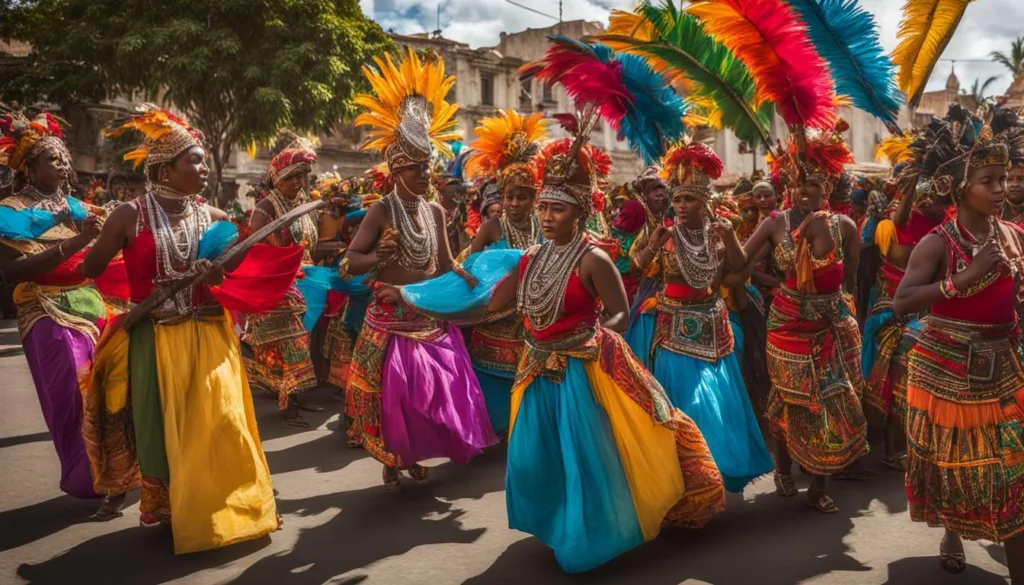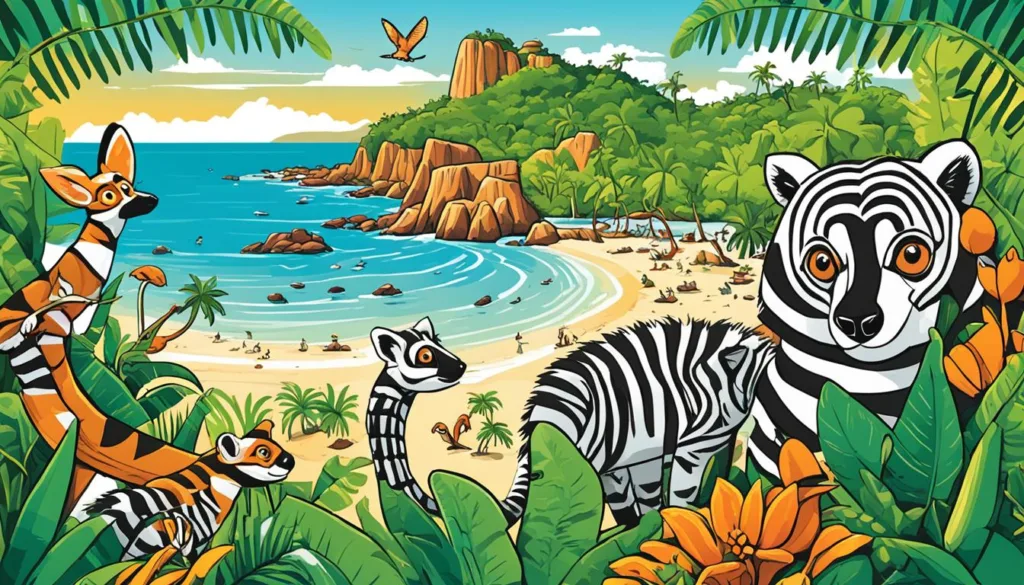Madagascar, a place of untold diversity and natural riches, lures travelers with its unique wildlife and unspoiled beaches. With the island’s alluring biodiversity and landscapes, pinpointing the Best Time to Visit Madagascar could convert a simple getaway into the voyage of a lifetime. In this Madagascar travel guide, we unveil the optimal periods for your Madagascar vacation planning, blending climate wisdom with the pulse of its extraordinary habitats.
Roam through this enchanting island when nature unfurls her most vibrant hues. Between April and mid-December, the Malagasy ecosystem presents a symphony of color and life that is most vivid. Whether your heart yearns for the dance of lemurs, the tranquil embrace of azure waters, or the touch of silver sands, our Madagascar holiday advice offers insights to steer your compass towards the island’s peak periods of natural splendor.
Key Takeaways
- Mid-December to April is less traveled due to rains, but reveals Madagascar’s landscapes in their most lush and verdant state.
- April to October’s cooler climate makes it excellent for exploring Madagascar’s varied terrain and spotting wildlife.
- During July, August, and December, tourists flock to the island, presenting a vibrant, lively atmosphere – but also more crowds.
- The transitional months of November and May offer a balance between comfortable weather and robust wildlife activity.
- Special wildlife observances occur in October as many lemur species have their birthing season.
- Travel planning aligned with seasonal climatic variations ensures a fulfilling experience of Madagascar’s natural bounty.
Understanding Madagascar’s Climate for Ideal Travel Planning
Before you embark on your Madagascar adventure, familiarizing yourself with the local climate can be crucial to ensuring an enjoyable trip. The island’s location off the southeast coast of Africa means it experiences varied weather patterns, which have a significant influence on travel plans. To assist with your Madagascar travel tips, we’ll delve into how the trade winds and cyclone seasons could impact your journey.
The Influence of Southeastern Trade Winds
Madagascar’s weather is heavily influenced by the southeastern trade winds, which generate a notable divergence in seasonal conditions. During the austral winter months, the impact of these trade winds results in drier and warmer weather, perfect for exploring Madagascar’s diverse ecosystems without the hindrance of rain. Travelers can expect sea-level areas and the northern and western parts of the island to be quite warm, promoting leisurely beach days and uninterrupted wildlife expeditions.
Cyclone Season Risks: January to March Considerations
Conversely, the summer months from November to March see the Southeastern trade winds bringing in moisture-rich air, which can lead to hot, rainy days and the threat of cyclones, particularly in the eastern coastal areas. Obtaining current Madagascar climate information during this period is crucial for travelers. January through March marks the heart of the cyclone season, when your Madagascar travel plans may face the challenges of extreme weather, including heavy rainfall that can lead to impassable roads and potential accommodation closures.
As a visitor seeking the best Madagascar travel tips, it’s beneficial to schedule your journey during times when the risk of cyclones is minimal and the weather conditions favor outdoor activities. By doing so, not only will you have a more pleasant experience, but you’ll also ensure your safety and comfort while exploring this magnificent island.
Appreciating Madagascar’s climate intricacies can enhance your travel experience immensely, allowing you to prepare adequately for the conditions you’ll encounter. Whether you’re journeying to witness the extraordinary wildlife or to soak up the sun on the island’s famed beaches, factoring in Madagascar’s weather patterns is an essential part of any well-thought-out travel itinerary.
Exploring Madagascar’s Diverse Seasons: Where to Go and When
Madagascar’s climate is as diverse as its wildlife, presenting a kaleidoscope of conditions that vary dramatically from region to region. Successful Madagascar travel planning hinges on understanding these microclimates, ensuring your trip coincides with the optimal Madagascar tourist season for your chosen destinations.
Whether your itinerary draws you to the lush rainforests of the east or the baobab-studded avenues in the west, knowing where to go and when can make all the difference between a good vacation and a great one. Below, discover a guide designed to enhance your journey through this unique ecosystem.
| Region | Climate Type | Ideal Travel Months | Key Attractions |
|---|---|---|---|
| Northern Madagascar | Semi-dry Tropical | May – mid-November | Antsiranana, Mahajanga |
| Eastern Madagascar | Subequatorial | September – November | Rainforest exploration |
| Southern Madagascar | Semi-desert | March – May, September – November | Coastal Regions, Toliara |
| Western Madagascar | Dry | April – November | Avenue of the Baobabs, Morondava |
| Central Highlands | Temperate | September – November | Antananarivo, Antsirabe |
To fully immerse yourself in the intricacies of Madagascar’s landscapes, a nuanced approach to your travel timeline is key. Keep in mind that the central Highlands can be quite cold in winter, making summer months a preferable time for those who prefer milder weather. By tailoring your travel dates to the regional climates, you ensure a smoother, more enjoyable experience, whether you’re photographing the iconic baobabs or adventuring through the island’s storied rainforests.
Mesmerizing Wildlife Encounters: Picking the Perfect Season
Embarking on a journey dedicated to observing Madagascar wildlife requires a keen understanding of the best times to witness these creatures in their natural habitat. A well-crafted Madagascar travel guide emphasizes the significance of timing, accentuating how it can transform a simple getaway into a series of extraordinary wildlife encounters.
Lemur Spotting in the Birthing Season
Witnessing the rich biodiversity of Madagascar starts with lemur spotting during the magical birthing season. Come October, the forests come alive with the sights and sounds of these fascinating primates embracing their new young. Eager wildlife enthusiasts flock to Madagascar’s reserves to catch a glimpse of this annual spectacle.

Bird Watching and Reptile Activity as Temperatures Warm
As the island transitions from the cool austral winter to the warmer months, September through December sees a noteworthy uptick in bird and reptile activity. This period promises abundant opportunities for visitors to discover the vibrant bird species and secretive reptiles that call Madagascar home. Whether one is a seasoned birder or simply an admirer of nature’s diversity, this season is ideal for those with a penchant for the feathery and the scaled.
- Foraging lemurs in the colorful canopies
- Diverse bird songs piercing through the forest air
- Reptiles basking under the warm Malagasy sun
With the right timing, your trip to Madagascar can become a treasure trove of wildlife memories, each waiting to be discovered in the perfect season that nurtures the natural circle of life.
Beach Paradise Timing: Soak Up the Sun Without The Crowds
Madagascar, a country famed for its diverse ecosystem and unique wildlife, is also home to some of the world’s most extraordinary beaches. Whether you’re planning a serene getaway or a dynamic marine adventure, understanding the optimal times for beach vacations is key.
July to December: Beach Excursions with Milder Weather
The window from July to December is truly the golden period for Madagascar beaches. With milder weather prevailing, especially in the peak of July and August, beachgoers can bask in alluring sunsets and warm sands without battling the excessive heat or the holiday crowds. This period is perfect for those delving into Madagascar vacation planning with an emphasis on relaxation and sun-soaked leisure.
Whale Watching: A Seasonal Highlight on the East Coast
For those enchanted by marine life, the east coast of Madagascar presents a breathtaking opportunity to witness humpback whale migrations. This awe-inspiring event peaks from June to September, making whale watching tours a must-add to your itinerary. It’s not just about the golden sands; it’s a chance to be part of an incredible natural spectacle.
Key considerations when planning a beach holiday in Madagascar:
- Verify local weather patterns for the preferred travel window
- Plan ahead to secure accommodations, as some regions can be popular
- Incorporate wildlife tours for an enriching travel experience
A Madagascar vacation intertwines the serenity of untouched beaches with the thrill of wildlife encounters, offering travelers a blend of experiences found nowhere else on Earth.
The Best Time to Visit Madagascar for Cultural Events and Festivities
If you’re planning a trip to Madagascar and looking to immerse yourself in its rich cultural tapestry, timing your visit to coincide with the island’s vibrant celebrations can be a truly enriching experience. The cultural calendar in Madagascar is dotted with events that are not to be missed, and travelers interested in local traditions and festivities will find particular months especially rewarding.
Independence Day Celebrations in June
Madagascar’s Independence Day on June 26th is a monumental occasion celebrated across the nation with fervor and pride. This day is marked with grand parades, lively music, and dance, offering a deep dive into the heart of Malagasy patriotism and culture. As June ushers in cooler weather and a decline in tourist numbers, it becomes an ideal period for visitors to partake in the festivities without the overwhelming crowds.

Festival Vibes: Embracing Madagascar’s Art and Music Scene
Equally compelling for culture enthusiasts is the rhythm of Madagascar’s music and art scene, which comes to life during the Zegny Zo and Donia festivals. Zegny Zo, held in May, and Donia, celebrated in September, showcase an explosion of Malagasy artistic expression, with performances that span traditional music, dance, and visual arts.
| Event | Date | Location | Activities |
|---|---|---|---|
| Independence Day | June 26th | Nationwide | Parades, Music, Dance |
| Zegny Zo Festival | May | Antananarivo | Art Exhibitions, Performances |
| Donia Festival | September | Nosy Be | Concerts, Dance, Local cuisine |
To fully appreciate the breadth of Madagascar cultural events, integrating these into your Madagascar travel tips will enhance your journey, offering not just sightseeing but a true sense of the island’s spirit and pageantry. So, plan accordingly and you may just find yourself dancing alongside the welcoming Malagasy community in celebration of their heritage.
Madagascar Vacation Planning: From Weather Trends to Wildlife Sightings
Embarking on a journey to Madagascar requires thoughtful planning, especially when considering the dynamic weather patterns and their impact on the island’s unique flora and fauna. This Madagascar travel guide is designed to assist you in crafting the perfect itinerary by providing essential Madagascar climate information and valuable Madagascar travel tips.
Travel Tips Regarding Weather Extremes
Madagascar’s weather is a tale of two extremes: the balmy wet season and the cool, dry season. By equipping yourself with knowledge about these weather trends, you can ensure that your adventure is both safe and fulfilling. Pack appropriate clothing and gear for sudden rainfall or unanticipated cold spells if you’re traveling in the transitional seasons. Moreover, always stay updated on local weather advisories.
A Month-by-Month Guide to Madagascar’s Natural Spectacles
Each month unveils different facets of Madagascar’s rich biodiversity. Below is a comprehensive month-by-month breakdown to help you decide when to plan your visit for optimal wildlife viewing experiences:
| Month | Weather Conditions | Wildlife Events |
|---|---|---|
| January – March | Lush landscapes post-rains, cyclone potential, humid | Late baby lemur sightings, vibrant bird life |
| April – June | Mild temperatures, decreasing rainfall | Start of lemur mating season, flora in bloom |
| July – September | Cooler weather, excellent for hikes | Reptile breeding season, humpback whale migration |
| October – November | Warm and dry, comfortable for exploration | Lemur birthing season, abundant wildlife |
| December | Hot, start of wet season, early storms | Fledgling and juvenile birds, active wildlife |
Planning your trip around these weather trends and natural events can profoundly enhance your experience. Yet, it’s important to approach your Madagascar adventure with flexibility, as the climate can be unpredictable and every wildlife encounter is unique.

Conclusion
Embarking on a journey to Madagascar is to open oneself to an island of staggering biodiversity and breathtaking vistas. The essence of Madagascar vacation planning lies in harmonizing your travel itinerary with the ebb and flow of the island’s seasons, allowing you to bask in its full glory. Whether you crave the tranquility of azure beaches, the vibrant dance of cultural festivals, or the thrilling sight of lemurs in their natural habitat, the timing of your visit is pivotal to the experiences you’ll cherish.
Maximizing Your Visit: A Synthesized Madagascar Travel Guide
Compiling the insights from the travel guide, savvy travelers will align their Madagascar holiday advice to the climatic rhythms of their chosen locales within this magnificent land. Prioritizing destinations based on seasonal accessibility not only optimizes wildlife sightings but also enhances the comfort and enjoyment of every beach excursion, rainforest trek, and city exploration. To truly capture the spirit of Madagascar, one must merge their pursuit of adventures with the nuances of the isle’s diverse climates.
Madagascar Holiday Advice: Embrace the Unexpected
As with any great adventure, the allure of Madagascar is partly in its predictability and partly in its surprises. While meticulous planning lays the groundwork for a vacation of a lifetime, it’s the impromptu discoveries and unforeseen delights that often leave an indelible mark on one’s memory. So, pack your bags with a blend of anticipation and adaptability, for the unexpected is part and parcel of the intrepid Madagascar holiday experience. Let the island’s rhythmic beats guide you through an epic narrative that promises both marvel and mystery.






